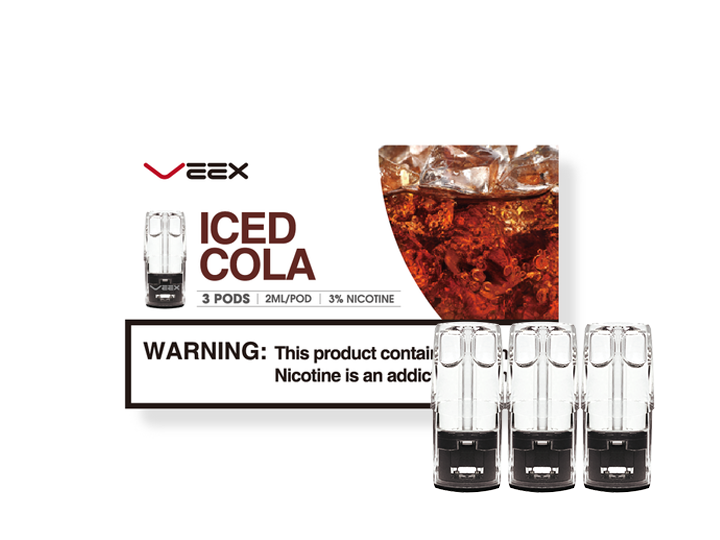How is the nicotine in vaping different?
May 28, 2022
For a long time, tobacco products have been listed as the most harmful products, especially damage to the respiratory tract and cardiovascular and cerebrovascular diseases. But this is completely different for vape because they neither burn nor produce smoke. For example, the nicotine contained in vape flavors of VEEX, TAKI, and WUUZ is pharmaceutical-grade nicotine.
Nicotine is easily addictive because it changes the way our brains work, triggering cravings for more when we don't consume it for long periods. Some nicotine products, including e-cigarette flavors and cigarettes, quickly deliver nicotine into the bloodstream and are absorbed by the brain in a fraction of a second. Because the brain is developing, teens and young adults are at higher risk of becoming highly addicted.
Most vape sites require visitors to declare their age before viewing content. Synthetically produced nicotine e-cigarette products use nicotine and are less restricted by tobacco product legislation. But what is synthetic nicotine and how safe is it?
Synthetic nicotine with tobacco nicotine
Nicotine is a stimulant that can lead to addiction after a period of consumption. The largest source of nicotine is the tobacco plant, which has a high concentration, and nicotine can also be extracted from other unexpected sources, such as nightshade plants, but at very low concentrations. It has been established that small amounts of nicotine are found in common foods such as green peppers, potatoes, cocoa, and tomatoes.
The nicotine contained in cigarettes is a chemical that makes people addicted to cigarettes, but there are better and safer ways to consume it: from regular cigarettes to electronic cigarettes. Most of the carcinogens, tar, and toxic gases in vaping have been removed. Vape systems and vape juices are widely available, and vapers can choose their favorite flavors and nicotine intensities.
For example, if you've ever been a cigarette user, you might opt for a 5% nicotine-intensity vape flavor, such as TAKI T50 disposable vape, which will provide the same experience as a cigarette. If you want to reduce your nicotine consumption, then starting here, your next step will be 3% nicotine intensity, such as TAKI T31 disposable vape, followed by zero nicotine vape flavors, such as VEEX V1 nicotine-free pod. Vape can achieve precise control of nicotine content, which is difficult for ordinary cigarettes to do.
Vape flavor used in Vape juice contains pharmaceutically refined nicotine, also known as free alkali nicotine, which is extracted from tobacco plants using a chemical process. The final product is a distillate of natural nicotine with a purity of 99.9%. Medicinal grade nicotine is then mixed with other liquid concentrates (propylene glycol and/or vegetable glycerin) and some flavoring agents to improve the taste. So, what is the difference between synthetic nicotine and tobacco-derived nicotine?

Synthetic nicotine
Today, a large percentage of e-cigarette flavors are produced using tobacco-derived nicotine. In addition, researchers have devised methods for producing pure nicotine from non-tobacco products in the laboratory. Synthetic nicotine, also known as tobacco-free nicotine, is an artificial replica of common nicotine derived from tobacco products (stems, leaves, waste, or extracts), but it is produced using chemicals.
Is tobacco-free nicotine safe for humans?
While synthetic nicotine may sound fresh, especially for newbies and non-e-cigarette-smoking communities, it's been around for a long time. Vape flavor manufacturers have been using this option to produce their products. Now, the industry seems to have embraced it and is moving in the direction of fully realizing it. That being said, that doesn't necessarily mean that everything about synthetic nicotine is known.
While synthetic nicotine is purer than medicinal grade nicotine, there is no real difference between tobacco-free nicotine and traditional nicotine. While there may be some additives, such as improved taste, tastelessness, and odorless properties, overall, tobacco-free nicotine is as safe as regular tobacco-derived nicotine.
Tobacco-derived nicotine
Nicotine is a chemical stimulant that occurs naturally in tobacco trees, and tobacco-derived nicotine is pure nicotine. When large amounts of nicotine from tobacco are consumed, the chemical is absorbed into the bloodstream and delivered to the brain system. Most users have a general who contributes to seductive and stimulating effects. Independent nicotine does not cause catastrophic effects on the body, but high concentrations of nicotine can cause side effects such as nausea, headache, drowsiness, fatigue, tremors, and palpitations.
To make it more effective, ammonia is added to tobacco-derived nicotine to produce "free alkali nicotine." In this way, pure nicotine is more effective and easier to absorb in the body. The vast majority of e-cigarette flavors in the industry contain free alkali nicotine.
LAST:
NEXT:

![[HOT] TAKI T32 Mini Cup Vape - Mini cup Disposable vape - 15ml-6000puffs-veexshop](http://img.staticdj.com/ac8d91f55827bcb8bc808b1a99e3d1af_{width}x.jpg)

![[CLASSIC] VEEX V1 Transparent Pods-veexshop](http://img.staticdj.com/97093a38bf996679e92aceff3ba50320_{width}x.png)
![[NEW] TAKI T50 Disposable Vape-veexshop](http://img.staticdj.com/6e96e053550a2072a0c59990e5ad798c_{width}x.png)